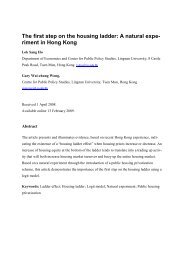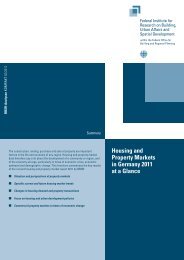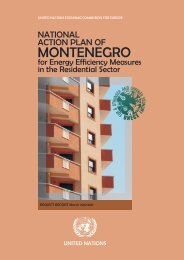housing developments in european countries - Department of ...
housing developments in european countries - Department of ...
housing developments in european countries - Department of ...
Create successful ePaper yourself
Turn your PDF publications into a flip-book with our unique Google optimized e-Paper software.
Section 4<br />
Outcomes<br />
Outcomes Section 4<br />
shortages <strong>in</strong> Lithuania are concentrated <strong>in</strong> the biggest<br />
cities, especially <strong>in</strong> Vilnius and Klaipeda regions. In<br />
the com<strong>in</strong>g decades. In England this <strong>in</strong>creased demand<br />
will be underp<strong>in</strong>ned by cont<strong>in</strong>u<strong>in</strong>g growth <strong>in</strong> the<br />
Only three <strong>of</strong> the governments that participated <strong>in</strong> this<br />
review reported the possibility that <strong>hous<strong>in</strong>g</strong> demand<br />
4.6 Equilibrium<br />
Slovenia <strong>hous<strong>in</strong>g</strong> demand is also strongest <strong>in</strong> urban<br />
areas, particularly the capital Ljubljana. In Estonia,<br />
demand is strongest <strong>in</strong> the capital city Tall<strong>in</strong>n and <strong>in</strong><br />
the Harju region which surrounds it. These areas<br />
currently account for some 72% <strong>of</strong> the total value <strong>of</strong><br />
real estate transactions <strong>in</strong> the country, whereas <strong>in</strong> rural<br />
areas demand and house prices are very low, to the<br />
number <strong>of</strong> new households, which is expected to rise<br />
from 20,905 new household formations <strong>in</strong> 2002, to<br />
22,519 <strong>in</strong> 2011 and to 24,000 by 2021. In Malta<br />
demand for smaller <strong>hous<strong>in</strong>g</strong> units, both for first-time<br />
buyers on the market as well as for households<br />
await<strong>in</strong>g allocation <strong>of</strong> social <strong>hous<strong>in</strong>g</strong>, is expected to be<br />
particularly strong. The population structure <strong>of</strong> Poland<br />
would not exceed supply <strong>in</strong> the medium term. If<br />
<strong>hous<strong>in</strong>g</strong> output plans proposed under the terms <strong>of</strong><br />
Slovenia’s National Hous<strong>in</strong>g Programme which was<br />
adopted <strong>in</strong> 2000, are realised, <strong>hous<strong>in</strong>g</strong> output should<br />
<strong>in</strong>crease to 10,000 new dwell<strong>in</strong>gs annually by 2009,<br />
which would satisfy the overall demand for <strong>hous<strong>in</strong>g</strong> <strong>in</strong><br />
the country. Future <strong>hous<strong>in</strong>g</strong> demand <strong>in</strong> Romania is<br />
As mentioned above, <strong>in</strong> the vast majority <strong>of</strong> European<br />
<strong>countries</strong> either the <strong>hous<strong>in</strong>g</strong> market as a whole, or<br />
specific segments <strong>of</strong> it, are <strong>in</strong> disequilibrium at the<br />
current time. This Section describes the key factors that<br />
have contributed to this situation and the policies and<br />
programmes which have been <strong>in</strong>troduced to address it.<br />
extent that these areas lack a properly function<strong>in</strong>g<br />
property market. Even <strong>in</strong> Turkey, where the present<br />
is atypical <strong>in</strong> European terms and this is expected to<br />
fuel <strong>hous<strong>in</strong>g</strong> demand <strong>in</strong> com<strong>in</strong>g years. The Polish birth<br />
difficult to predict. On the one hand, demographic<br />
projections <strong>in</strong>dicate that the Romanian population will<br />
4.6.1 Disequilibrat<strong>in</strong>g Factors<br />
authorised and unauthorised <strong>hous<strong>in</strong>g</strong> stock matches<br />
demand on a nationwide basis, there is currently a<br />
shortage <strong>of</strong> <strong>hous<strong>in</strong>g</strong> <strong>in</strong> the prov<strong>in</strong>ces <strong>of</strong>: Ardahan,<br />
Bitlis, Hakkari, Kars, and Sakarya.<br />
4.5.3 Projected Demand<br />
In a majority <strong>of</strong> the <strong>countries</strong> exam<strong>in</strong>ed <strong>in</strong> this review,<br />
rate was high until the early 1980s, and <strong>in</strong>dividuals<br />
born dur<strong>in</strong>g that time will be reach<strong>in</strong>g the usual family<br />
formation age <strong>in</strong> the near future. In Latvia <strong>hous<strong>in</strong>g</strong><br />
demand between 2003 and 2013 is projected to be<br />
50,000 units. In Lithuania the number <strong>of</strong> households is<br />
expected to grow, net migration will become positive<br />
and household <strong>in</strong>comes are also expected to expand. In<br />
order to satisfy the <strong>in</strong>crease <strong>in</strong> the demand for <strong>hous<strong>in</strong>g</strong><br />
shr<strong>in</strong>k considerably over the next decades. However,<br />
on the other hand, average household size will<br />
probably dim<strong>in</strong>ish due to the age<strong>in</strong>g <strong>of</strong> the population<br />
and the change <strong>in</strong> social patterns. The demand for new<br />
<strong>hous<strong>in</strong>g</strong> may be <strong>in</strong>creased due to the poor standard <strong>of</strong><br />
the exist<strong>in</strong>g <strong>hous<strong>in</strong>g</strong> stock and more demand for<br />
owner-occupied <strong>hous<strong>in</strong>g</strong> <strong>in</strong> preference to rent<strong>in</strong>g. In<br />
Portugal, demand is expected to decl<strong>in</strong>e <strong>in</strong> the medium<br />
The various factors that have contributed to<br />
unbalanced demand and supply <strong>in</strong> national and<br />
regional <strong>hous<strong>in</strong>g</strong> markets <strong>in</strong> European <strong>countries</strong> are<br />
summarised <strong>in</strong> TABLE 4.6.1. This table highlights some<br />
factors that have disequilibrated <strong>hous<strong>in</strong>g</strong> markets <strong>in</strong> a<br />
significant number <strong>of</strong> <strong>countries</strong> across Europe and<br />
others which are particular to specific parts <strong>of</strong> Europe.<br />
demand for <strong>hous<strong>in</strong>g</strong> is expected to grow over the next<br />
decade but <strong>in</strong> some cases, demand is to grow at more<br />
moderate levels than has been the case <strong>in</strong> the recent<br />
past. In France, <strong>hous<strong>in</strong>g</strong> demand is expected to fall<br />
from 320,000 dwell<strong>in</strong>gs per annum between 2000 and<br />
2004 to 290,000 dwell<strong>in</strong>gs per annum between 2005<br />
and 2009. In Ireland demand for <strong>hous<strong>in</strong>g</strong> is expected<br />
to cont<strong>in</strong>ue to rise, fuelled by population growth and<br />
chang<strong>in</strong>g patterns <strong>of</strong> household formation, but it will<br />
beg<strong>in</strong> to abate after 2006, with stronger levels <strong>of</strong><br />
reduction occurr<strong>in</strong>g after 2010. Hous<strong>in</strong>g demand <strong>in</strong><br />
Spa<strong>in</strong> is expected to grow less rapidly <strong>in</strong> the mediumterm<br />
than at present as a result <strong>of</strong> a number <strong>of</strong> factors,<br />
such as economic growth and growth <strong>in</strong> household<br />
disposable <strong>in</strong>come, availability <strong>of</strong> mortgage f<strong>in</strong>ance<br />
and negative population change. In F<strong>in</strong>land demand<br />
for <strong>hous<strong>in</strong>g</strong> will reach 35,000 new <strong>hous<strong>in</strong>g</strong> units per<br />
created by these <strong>developments</strong>, 100,000 to 120,000<br />
dwell<strong>in</strong>gs will be required over the next 10 years. In<br />
the Czech Republic, ris<strong>in</strong>g household <strong>in</strong>comes as a<br />
result <strong>of</strong> economic stabilisation are expected to lead to<br />
<strong>in</strong>creased demand for <strong>hous<strong>in</strong>g</strong> <strong>in</strong> the future. Policy<br />
<strong>in</strong>terventions are <strong>in</strong>tended to spread economic growth<br />
evenly however they will have implications for the<br />
average <strong>in</strong>comes <strong>of</strong> different regions which <strong>in</strong> turn will<br />
accentuate regional differences <strong>in</strong> demand.<br />
In Bulgaria, a number <strong>of</strong> issues such as an economic<br />
stabilisation, <strong>in</strong>creased availability <strong>of</strong> mortgage<br />
f<strong>in</strong>ance, grow<strong>in</strong>g <strong>in</strong>vestments <strong>in</strong> <strong>hous<strong>in</strong>g</strong> by foreigners<br />
and employed Bulgarian citizens, and <strong>in</strong>creased<br />
demand for home ownership <strong>in</strong> preference to rented<br />
<strong>hous<strong>in</strong>g</strong> are also expected to affect <strong>in</strong>creas<strong>in</strong>g demand<br />
for <strong>hous<strong>in</strong>g</strong>. Similar factors are also expected to fuel<br />
term as a result <strong>of</strong> the abolition <strong>of</strong> subsidies for<br />
mortgage loans <strong>in</strong> 2002.<br />
For <strong>in</strong>stance, scarcity <strong>of</strong> development land, particularly<br />
<strong>in</strong> urban areas where <strong>hous<strong>in</strong>g</strong> demand is generally<br />
greatest, is an issue <strong>in</strong> most parts <strong>of</strong> Europe. This<br />
<strong>in</strong>cludes: F<strong>in</strong>land, Ireland, Lithuania, Malta, Portugal,<br />
Romania, Slovakia, Slovenia, Spa<strong>in</strong> and Turkey.<br />
Problems <strong>in</strong> relation to the efficient operation <strong>of</strong><br />
plann<strong>in</strong>g, procurement and build<strong>in</strong>g control systems<br />
are also an issue <strong>in</strong> a number <strong>of</strong> <strong>countries</strong>, <strong>in</strong>clud<strong>in</strong>g:<br />
Estonia, Ireland, Latvia, Lithuania, Portugal, Romania<br />
and Sweden and Turkey. In addition, <strong>in</strong> three <strong>countries</strong><br />
(the Czech Republic, Denmark and Malta), rent<br />
control is a significant impediment to <strong>in</strong>vestment <strong>in</strong> the<br />
private rented sector, while ris<strong>in</strong>g and high<br />
construction costs and lack <strong>of</strong> availability <strong>of</strong> skilled<br />
build<strong>in</strong>g workers is an issue <strong>in</strong> Cyprus, Ireland,<br />
Lithuania, Romania, Sweden and the United K<strong>in</strong>gdom.<br />
year <strong>in</strong> the period 2006 to 2010, ris<strong>in</strong>g to 36,000<br />
dwell<strong>in</strong>gs per year between 2011 and 2015. The<br />
current level <strong>of</strong> <strong>hous<strong>in</strong>g</strong> construction is around 27,000<br />
dwell<strong>in</strong>gs per annum. In the Netherlands, it is expected<br />
that the <strong>hous<strong>in</strong>g</strong> shortage will amount to 2.3%, as<br />
compared to 2.5% currently unless <strong>hous<strong>in</strong>g</strong><br />
construction <strong>in</strong>creases significantly.<br />
On the other hand, <strong>in</strong> a number <strong>of</strong> <strong>countries</strong> demand<br />
for <strong>hous<strong>in</strong>g</strong> is expected to <strong>in</strong>crease significantly over<br />
cont<strong>in</strong>ued growth <strong>in</strong> demand for <strong>hous<strong>in</strong>g</strong> <strong>in</strong> Estonia, <strong>in</strong><br />
urban areas <strong>in</strong> particular, which is unlikely to be<br />
satisfied by the supply <strong>of</strong> new dwell<strong>in</strong>gs. The Turkish<br />
government’s five-year development plan for <strong>hous<strong>in</strong>g</strong><br />
which covers the period 2001 to 2005 predicts that, as<br />
a result <strong>of</strong> population growth, the need for renovation<br />
and replacement <strong>of</strong> sub-standard dwell<strong>in</strong>gs, and the<br />
need for <strong>hous<strong>in</strong>g</strong> for those made homeless as a result<br />
<strong>of</strong> disasters, a total <strong>of</strong> 3,075,000 new dwell<strong>in</strong>gs will be<br />
required between these years.<br />
At the same time, the factors which have unbalanced<br />
<strong>hous<strong>in</strong>g</strong> demand and supply <strong>in</strong> the majority <strong>of</strong> Central<br />
and Eastern European States are quite dist<strong>in</strong>ct from<br />
those common <strong>in</strong> the other <strong>countries</strong> under<br />
exam<strong>in</strong>ation. In Bulgaria, Hungary, Latvia, Lithuania,<br />
Romania, Slovakia and Turkey, low household <strong>in</strong>comes<br />
have impeded the supply <strong>of</strong> new <strong>hous<strong>in</strong>g</strong> because<br />
demand is not supported by the ability to purchase or<br />
rent. In addition, the private sector <strong>in</strong> these <strong>countries</strong><br />
has failed to compensate for the withdrawal <strong>of</strong> the<br />
State as the pr<strong>in</strong>cipal funder <strong>of</strong> <strong>hous<strong>in</strong>g</strong> construction.<br />
146 European Union Report<br />
Regular National Report on Hous<strong>in</strong>g Developments <strong>in</strong> European Countries<br />
147

















